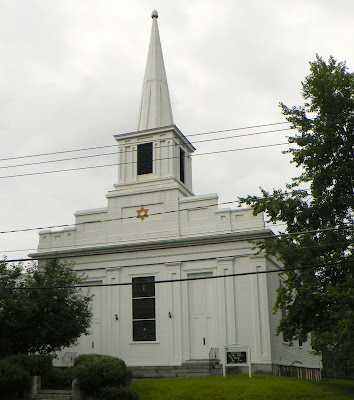Triangle Street, Amherst
The current reconstruction of Triangle Street at the gateway to UMass is expected to be completed mid-to-late September.
But if the process followed the pattern of the original construction of the road back in 1820, it would take a l-o-t longer. Amherst had its very own Civil War over the roadwork, dubbed "The Triangle Street Fight" by Morehouse and Carpenter in their definitive "History of the town of Amherst, Massachusetts."
Back then town center was known as the "West Village," and a prominent business -- the "Boltwood Tavern" -- was located where the ugly Bank of America now sits; while the "East Village" had a competing operation -- "Dickinson/Bagg's Tavern" -- located at the intersection of South East and Main Streets.
Since the Calvin Coolidge Bridge in Northampton was not yet built, travelers from the west had to cross over the Connecticut River in Sunderland and make their way south to Amherst where they would first encounter the tavern in town center, giving it a distinct advantage over the one located a mile or so to the east.
The First Congregational Church, founded 1739, is also located on Main Street between the Dickinson Homestead and town center ("West Village") and it was in competition with the more recent 1782 break away Second Congregational Church.
The First Congregational Church was also more loyal to the British during the Revolutionary War, motivating the more patriotic parishioners to seek God elsewhere, as in the "East Village."
Thus Triangle Street became a more efficient route to points east but in so doing bypassed town center ... and the Boltwood Tavern and the First Congregational Church. Town Meeting approved the road on December 4, 1820 but then ten days later that approval was overturned.
Well the citizens of "East Village" did not take kindly to that and simply decided to build the road themselves. The citizens in and around town center ("West Village") decided to enforce Town Meeting's vote to "discontinue" the road by sabotaging construction after workers went home for the night.
Road builders started stationing guards all along the new construction to keep watch overnight. Frustrated workers on both sides would then come to blows. Spectators from surrounding towns started showing up just to watch the nightly tussle.
Anti-road activists took to building a fence across the road to block transit. The pro-road builders destroyed the fence as quickly as it could be constructed.
Finally, on May 17, 1821 Town Meeting voted to advise the Selectmen to "clear the encumbrances from the road and keep it clear." The Selectmen, keepers of the public ways, dutifully agreed and the "Triangle Street Fight" concluded.
A clear victory for capitalism, God and country.
But if the process followed the pattern of the original construction of the road back in 1820, it would take a l-o-t longer. Amherst had its very own Civil War over the roadwork, dubbed "The Triangle Street Fight" by Morehouse and Carpenter in their definitive "History of the town of Amherst, Massachusetts."
Amherst town center BoA: former home of "Boltwood Tavern"
Back then town center was known as the "West Village," and a prominent business -- the "Boltwood Tavern" -- was located where the ugly Bank of America now sits; while the "East Village" had a competing operation -- "Dickinson/Bagg's Tavern" -- located at the intersection of South East and Main Streets.
Since the Calvin Coolidge Bridge in Northampton was not yet built, travelers from the west had to cross over the Connecticut River in Sunderland and make their way south to Amherst where they would first encounter the tavern in town center, giving it a distinct advantage over the one located a mile or so to the east.
First Congregational Church, Main Street, Amherst
The First Congregational Church, founded 1739, is also located on Main Street between the Dickinson Homestead and town center ("West Village") and it was in competition with the more recent 1782 break away Second Congregational Church.
The First Congregational Church was also more loyal to the British during the Revolutionary War, motivating the more patriotic parishioners to seek God elsewhere, as in the "East Village."
East Village: Former 2nd Congregational Church, now Jewish Community of Amherst
Thus Triangle Street became a more efficient route to points east but in so doing bypassed town center ... and the Boltwood Tavern and the First Congregational Church. Town Meeting approved the road on December 4, 1820 but then ten days later that approval was overturned.
Main and Triangle Street intersection
Well the citizens of "East Village" did not take kindly to that and simply decided to build the road themselves. The citizens in and around town center ("West Village") decided to enforce Town Meeting's vote to "discontinue" the road by sabotaging construction after workers went home for the night.
East Village: Dickinson-Bagg's Tavern South East/Main Street intersect, now legal offices
Former Dickinson-Bagg's Tavern
Road builders started stationing guards all along the new construction to keep watch overnight. Frustrated workers on both sides would then come to blows. Spectators from surrounding towns started showing up just to watch the nightly tussle.
Anti-road activists took to building a fence across the road to block transit. The pro-road builders destroyed the fence as quickly as it could be constructed.
Finally, on May 17, 1821 Town Meeting voted to advise the Selectmen to "clear the encumbrances from the road and keep it clear." The Selectmen, keepers of the public ways, dutifully agreed and the "Triangle Street Fight" concluded.
A clear victory for capitalism, God and country.
Boltwood Tavern in town center became Amherst House in 1838, burned to the ground July 4, 1879
Lovell, John L., 1825-1903, "Amherst House before 1879," in Digital
Amherst, Item #467, http://www.digitalamherst.org/items/show/467
(accessed August 13, 2013).



















































